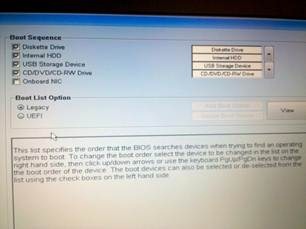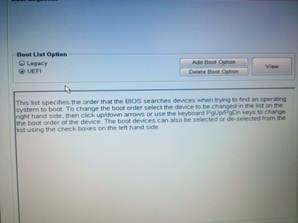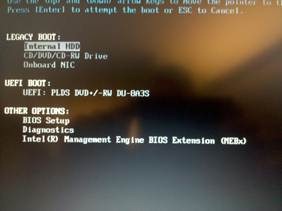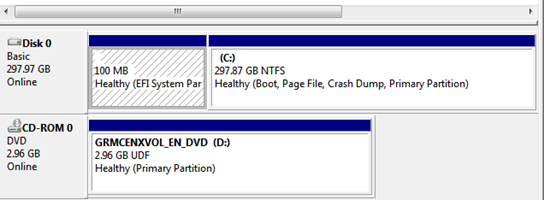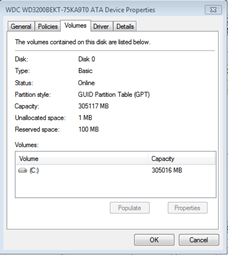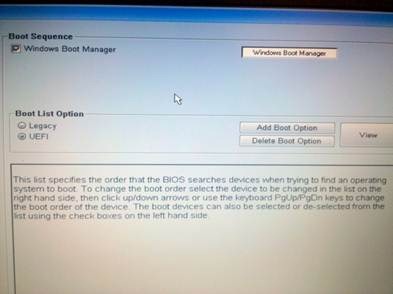Installing Windows 7 on UEFI based computer
Many new computers are shipping with the option to boot Unified Extensible Firmware Interface (UEFI) instead of standard BIOS. In today’s blog I walkthrough how I installed Windows 7 SP1 X64 Enterprise on a Dell Latitude E6410 laptop that supports UEFI.
The screenshots are specific to a Dell E6410 laptop but you should similar type screens on other UEFI based machines. For more information contact the manufacturer of the computer.
1. Upgrade to latest BIOS. Before you install in UEFI mode you should generally check with the vendor to make sure the BIOS is up to date.
2. Configure the computer for UEFI. Most UEFI based computers will also support legacy BIOS boot. This is configured in the BIOS. The following shows the computer is set for Legacy Boot and the boot options available with Legacy Boot
Figure 1. Legacy Boot Options
Figure 2. Configure BIOS for UEFI or Legacy
3. Insert Windows 7 SP1 X64 DVD. Note: One of the common issues we see is that users try to install X86 version with UEFI enabled in the bios. X86 does not support UEFI so you would have to configure the machine for Legacy boot to install X86 versions of Windows. If you do try to install X86 version setup will run but on the 1st reboot you will get BIOS error similar to “No bootable devices –Strike F1 to retry boot, F2 for setup utility. Press F5 to run onboard diagnostics”
4. Press F12 to choose to boot from the DVD and choose the UEFI boot option for the DVD
Note the UEFI option for the DVD under UEFI boot
Figure 3. UEFI boot option for Windows 7 DVD
5. Follow prompts to install Windows 7 just like any other install
Differences between UEFI vs. Legacy BIOS boot install
When complete you will a couple of differences compared to a legacy BIOS boot install.
You have the following default disk configuration:
· 100mb Fat32 EFI System Partition
· 128mb Microsoft Reserved Partition(will not appear in Disk Management but you can see it in the command line Diskpart tool)
Figure 4. Disk Management on UEFI computer
More information on the default partitioning for UEFI based computer can be found at https://technet.microsoft.com/en-us/library/dd744301(WS.10).aspx
In the properties of the disk you also see that we setup a GPT partition table instead of MBR:
Figure 5. GPT Partition Table
If you run Bcdedit /enum you will see the following entries in the BCD store.
Windows Boot Manager
--------------------
identifier {bootmgr}
device partition=\Device\HarddiskVolume1
path \EFI\Microsoft\Boot\bootmgfw.efi
description Windows Boot Manager
locale en-US
inherit {globalsettings}
default {current}
resumeobject {c79ed24a-6d11-11e0-a52b-93ef911fd7fa}
displayorder {current}
toolsdisplayorder {memdiag}
timeout 30
Windows Boot Loader
-------------------
identifier {current}
device partition=C:
path \Windows\system32\winload.efi
description Windows 7
locale en-US
inherit {bootloadersettings}
recoverysequence {c79ed24c-6d11-11e0-a52b-93ef911fd7fa}
recoveryenabled Yes
osdevice partition=C:
systemroot \Windows
resumeobject {c79ed24a-6d11-11e0-a52b-93ef911fd7fa}
nx OptIn
On this particular Dell mode you can also see in the BIOS that Windows 7 setup added a new boot option
Figure 6. Windows Boot Manager entry in BIOS
Boot Option Name: Windows boot Manager
File System List: HD(1,GPT, 05F6D08B-563C-480D-AF3CB9FD1E973A33)
File Name: \EFI\Microsoft\Boot\bootmgfw.efi
If you are doing a large deployment to many machines not all deployment tools support UEFI yet so check with the vendor of the deployment tool to see if they support UEFI based computers.
Information on Microsoft deployment tools support for UEFI can be found at https://blogs.technet.com/b/askcore/archive/2011/03/25/deployment-options-for-uefi-based-computers.aspx
Hope this helps with your installs.
Scott McArthur
Senior Support Escalation Engineer
Microsoft Enterprise Platforms Support
